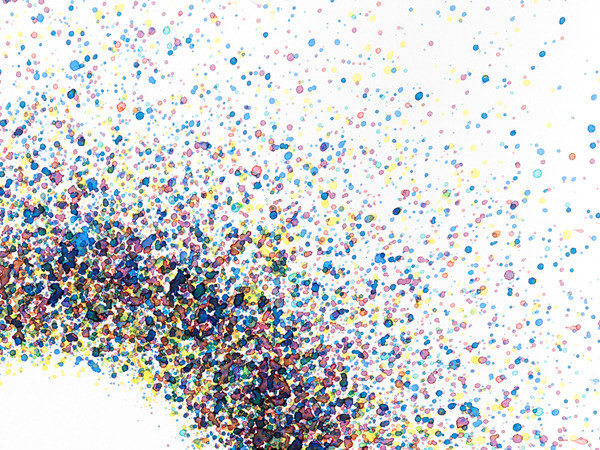Jeppe Hein
dal 18/9/2013 al 19/10/2013
Segnalato da
18/9/2013
Jeppe Hein
Church of St. Agnes, Berlin
You. 360degree Illusion III is a huge construction of two long, rectangular mirrors connected at right angles and placed on the gallery above the visitors' heads.

Johann König, Berlin is pleased to present its third exhibition in the nave of ST. AGNES. This time, a large mirror sculpture by Danish artist Jeppe Hein literally sends the visitors’ perception of themselves and of the
monumental architecture spinning and swaying. The exhibition is complemented by the artist’s latest works on paper.
360° Illusion III, the central work of the exhibition, is a huge construction of two long, rectangular mirrors connected at right angles and placed on the gallery above the visitors’ heads. The mirror object rotates
slowly around its axis, occupying the entire length, width and diagonals of the space. Thus, the viewer can see the space reflected from various perspectives on the mirrored surfaces. The two mirrors also produce a double reflection, creating the effect that the mirrored images of people and objects are rotating with the mirrors themselves. Although the viewer remains standing, his or her reflection turns downwards and then back up again. This illusion induces not only a vague feeling of dizziness but also a latent distrust of one’s own eyesight and spatial perception. As the mirrors display a different picture of the location, the viewer questions his or her position in the room.
“ ’Our own body is in the world as the heart is in the organism,’ wrote Maurice Merleau-Ponty in his incomparable analysis of perception’s phenomenological character. ‘It keeps the visible spectacle constantly alive, it breathes life into it and sustains it inwardly, and with it forms a system.’
This notion of the spectacle of the world as sustained by the mobile body is vital to Jeppe Hein’s works, which treat the viewer as an ‘embodied subject’ (to borrow Merleau-Ponty’s term) rather than a disembodied eye. Such a phenomenological approach is of course not new to Hein, but began already with Modernism’s move away from illusionism towards non-representational painting and sculpture in the early part of the twentieth century, requiring a more dynamic viewer. It was expanded on by the minimalist sculptors of the 1960s, whose forms were not supposed to be taken in isolation, but rather in relation to their context, and which viewers were required to experience in a physical, rather than just ocular, sense.
In Hein’s case, however, the objects are not only concerned with their relation to space. Their appeal to the embodied subject is explicit and they employ specific, often playful or light-hearted means to attract the viewer’s attention and use the body’s engagement as a conduit to the mind, or indeed vice versa. But why are these works so intent on attracting our attention? What do they want to tell us? Though no doubt sociable objects—they clearly wish to communicate—they are not concerned with the kind of ‘relational aesthetics’ which emerged in the 1990s and had specifically to do with the social aspects of the art-viewing context.
Although Hein’s objects may attract multiple spectators, and become the topic of conversation between them, their primary purpose is rather to attract the attention of the individual viewer. The object itself is not
primary, nor is the institutional context or the social relations of the group, but rather the spectator him or herself as an embodied subject, physically present in this particular moment and this particular place. In an almost tautological sense, we are asked to pay attention to attention itself. To realise the nature of our body as the heart of the world.
Jeppe Hein’s works employ seductive means to bring us up close with reality, face to face, you could say. They make it more evident, but they also hand it back to us. It is up to us to make something of it, to interact...feel... wonder..., for each one of us is in the world as the heart is in the organism.” (Kirsty Bell, “STEP RIGHT UP” in: Jeppe Hein. A Smile For You, Verlag der Buchhandlung Walther König, 2013)
Jeppe Hein (*1974 Copenhagen, Denmark) lives and works in Berlin. Since studying at the Royal Academy in Copenhagen and Städelschule in Frankfurt/Main (1997-1999) he has been part of numerous group exhibitions and has realized several works in public space. Among his most important solo exhibitions are A Smile For You (2013) at Bonniers Konsthall, Stockholm and Wanås Konst, Sweden, Robert-Jacobsen-Preisträger (2012) Museum Würth, Bad Mergentheim, Germany, 360˚ (2011) at the 21st Century Museum of Contemporary Art, Kanazawa, Japan; 1xMuseum, 10xRooms, 11xWorks (2010) at Neues Museum Nürnberg; Distance (2010)at IMA - Indianapolis Museum of Art, Indianapolis, USA, Sense City (2009) at AroS Museum of Art, Århus, Denmark. Besides extensive publications such as the catalogues of his solo exhibitions in Kanazawa and Århus, the monography Until Now (2007) with texts by Francesco Bonami, Christine Macel and others was published at Koenig Books just as the current publication A Smile For You (2013) accompanying the recent solo shows at Bonniers Konsthall and Wanås Konst. His works are parts of institutional collections such as the Tate Gallery, London; Centre Pompidou, Paris; Museum für Moderne Kunst, Frankfurt/Main; Museum of Contemporary Art, Los Angeles.
Image: Jeppe Hein, Frequency Watercolours (detail), 2013, Watercolour on paper, framed, 150 x 150 cm
Press preview in the presence of the artist: 19. September 2013, 9:30 - 11:30 am
Opening: 21. September 2013, 18 - 21 Uhr
ST. AGNES
Alexandrinenstr. 118-121, 10969 Berlin
Opening hours: Thu - Sun, 11am - 6pm



